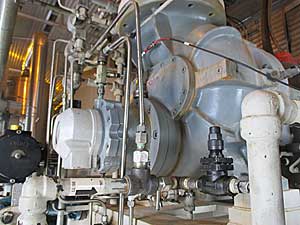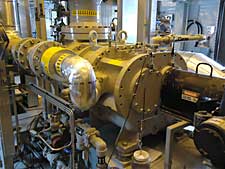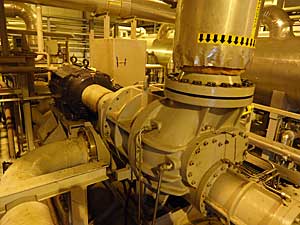Services
- Static Equipment & Structures (Piping Vibration & Fatigue)
- Acoustic Fatigue Assessment for Blowdown Systems
- Acoustic-Induced Vibration (AIV) Analysis
- Finite Element Analysis (FEA) and Computational Fluid Dynamics (CFD)
- Flow-Induced Turbulence (FIT) Analysis
- Flow-Induced Vibration (FIV) Analysis
- Multiphase and Slug Flow Analysis
- Pipe Stress Analysis
- Piping Vibration and Integrity Assessment
- Review & Design Support Services
- Small-Bore Connections (SBC) Assessment
- Structural Vibration and Dynamic Design Analysis
- Subsea Piping Vibration
- Thermal Striping
- Tube Failure Analysis
- Veridian AM
- Veridian VS
- Vibration Inspection Program
- Water Hammer Analysis
- Machinery Analysis
- Bottle Sizing Service
- Compressor Package Engineering
- Finite Element Analysis (FEA) and Computational Fluid Dynamics (CFD)
- Foundation Design and Dynamic Analysis
- Fuel Gas Compressor Piping Transient Analysis
- Lateral Vibration Analysis
- Pipe Stress Analysis
- Pulsation & Mechanical Analysis: Reciprocating Compressor
- Pulsation & Mechanical Analysis: Reciprocating Pump
- Pulsation & Mechanical Analysis: Screw Compressor
- Pump RCF Analysis
- Review & Design Support Services
- Shell Transverse Acoustical (STA) Analysis
- Skid Design and Analysis
- Surge Control Design for Centrifugal Compressor Systems
- Torsional Vibration Analysis (TVA)
- Field Engineering & Troubleshooting
- Finite Element Analysis (FEA) and Computational Fluid Dynamics (CFD)
- Human Vibration
- Motion Amplification Vibration Analysis
- Noise Troubleshooting
- Performance Assessment (Thermodynamic)
- PostPro – field data processing and analysis
- Structural Vibration Troubleshooting
- Thermal Striping
- Troubleshooting, Root Cause Analysis (RCA)
- Veridian iDAC
- Vibration Inspection Program
Pulsation & Mechanical Analysis: Screw Compressor
Including rotary compressors and Roots blowers

Screw compressors and Roots blowers create high frequency pulsations in the discharge piping. Wood’s Pulsation and Mechanical Analysis is used to minimize the interaction between these pulsations and the piping system, thereby avoiding vibration and noise problems. In addition to the resonance issues addressed in this analysis, other vibration and integrity issues should be addressed including small-bore piping, torsional vibration, and skid design.
Contents [ hide ]
1 Background
 |
 |
Screw compressors (wet and dry), Roots blowers (2 lobe and 3 lobe), and vane compressors are examples of positive displacement machines that generate pulsation energy at multiples of the pocket, lobe, or vane passing frequency. API Standard 619 outlines the design issues for screw compressors and re-iterates that pulsation problems exist. Per 619 5th Edition “the flow is not steady, but moves through the piping in a series of flow pulses that are superimposed upon the steady (average) flow”.
Vibration problems can occur when these pulsations cause acoustical resonance within the piping or resonate with the mechanical natural frequencies (MNFs) of the vessel shell walls or other piping. The high frequency pulsations inside the piping and vessel, combined with piping response, can also cause noise problems.
Dry screw compressors, often called oil free compressors, frequently require pulsation silencers on the discharge and suction systems. If pulsations aren’t attenuated over the wide frequency band, acoustical natural frequencies causing resonance and vibration can result.
Wet screw compressors, often called flooded compressors, inject oil in the suction system to improve the sealing, efficiency, and pressure ratios. Instead of silencers, a barrier is required to separate the oil from the gas stream. Pulsations can be resonant with the shell wall mechanical natural frequency cause severe noise and vibration, including excessive instrumentation and small-bore piping vibration.
To avoid vibration problems, a pulsation and mechanical analysis is used to evaluate the compressor and piping system. These studies are typically performed during the design stage and are also used to help identify and resolve problems that occur in the field.
 |
In combination with the pulsation analysis, the design will often evaluate the thermal piping expansion and support design using a Pipe Stress Analysis. This service is coordinated with the mechanical analysis to ensure the Pipe Stress Analysis accurately addresses vibratory loads.
Depending on the driver, gearboxes, and other factors, Wood is often asked to perform a torsional modal analysis.
Field vibration inspections are recommended to mitigate vibration and noise levels and perform a hot alignment (Essinger Bar Method) to meet the required guideline.
2 Scope of Analysis
2.1 Wet Screw Compressors (Flooded)
- Computer simulation analysis of discharge system to determine lower mode acoustical and mechanical natural frequencies and ensure that they are not coincident. Typical solutions may include the addition of orifice plates and/or the re-location or addition of pipe supports
- Calculation of higher mode acoustical (transverse waves) and mechanical (vessel shell) natural frequencies associated with the oil separator; again, to avoid coincidence. Typical solutions may include orifice plates or changes to the vessel wall thickness
2.2 Dry Screw Compressors (Oil Free)
- Acoustical computer simulation analysis of the piping between the compressor discharge and the inlet to the silencer. Any resonance response predicted can be reduced by optimizing the length of this piping or adding flow straightening devices
- Mechanical computer simulation analysis to determine the natural frequencies of the piping system, supports and structure and ensure there is no coincidence with pulsations generated at multiples of pocket passing frequency
- Silencer design (Baffle and choke tube sizing, typically)
2.3 Other Recommended Services for Screw Compressor Systems
- Small-Bore Connections (SBC) Assessment/Piping Design
- Pipe Stress Analysis of the discharge system, including analysis of nozzle stress
- Skid Design, including dynamic analysis
- Torsional Vibration Analysis (including coupling assessment)
- Lateral Vibration Analysis
2.4 Field Support
- Vibration Inspection Program - Vibration and Noise Measurements
- Troubleshooting, Root Cause Analysis (RCA)
3 Free webinar
Learn how to minimise the risk of vibration-related failures on screw compressor packages in our free webinar.
More Info
Free webinar
Learn how to solve complex vibration problems with advanced troubleshooting techniques to keep your facility running smoothly, with minimal downtime. Watch now





